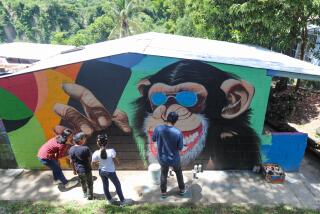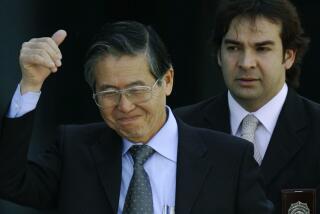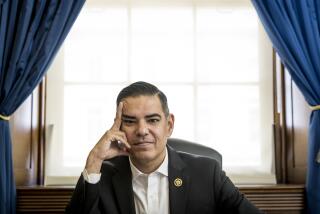A Sobered Garcia Returns to Power in Peru, Vowing Change
LIMA, Peru — Alan Garcia, reviled and driven into exile in the early 1990s, was sworn in Friday as president, seeking redemption for his disastrous earlier term that left the country in economic and political ruin.
Garcia, who fled the country in disgrace after his turbulent 1985-90 presidency ended in hyperinflation and a raging guerrilla war, has pledged to fight corruption, cut the salaries of the country’s bloated political class and seek better deals from mining and gas companies enjoying record profits.
“We have fallen into the vicious circle of more exports and more misery,” Garcia said in a sober inauguration speech before Congress and eight heads of state, including the presidents of neighboring Brazil, Bolivia and Chile. “It’s time to leave this vicious circle.”
He called reducing Peru’s 50%-plus poverty rate an urgent task, vowed to improve the nation’s long-ignored infrastructure and repeatedly emphasized responsibility and austerity -- a clear attempt to transcend his 1980s image, when his mercurial behavior had earned him the nickname “Caballo Loco,” or Crazy Horse.
“The state has become an obstacle for the people,” Garcia said, reading from a prepared text, which flattened his normally colorful speaking style.
His speech alternated between populist, high-spending themes and assurances of fiscal controls. He quoted Karl Marx and said that he planned to seek greater revenue from mining concerns, but was wary of scaring off foreign investment.
Garcia’s improbable comeback, the latest in a series of leadership shifts in Latin America, marks the return of one of the continent’s most colorful and unpredictable political personalities. Garcia, 57, can be a spellbinding orator, ruminating extemporaneously on global political and economic trends, but his calamitous first term left many deeply skeptical that he can run a government.
Many Peruvians recall the hours-long lines for bread, cooking oil, sugar and other necessities that marred Garcia’s 1980s administration, which presided over a cumulative inflation rate estimated at more than 2,000,000%. The spiraling social unrest aided leftist guerrillas, who set off bombs in the capital, downed power lines and exerted widespread control in universities and throughout the countryside.
Garcia’s administration was also implicated in alleged atrocities, including the summary executions of scores of rebel prisoners. He has denied any wrongdoing.
It was left to his successor, Alberto Fujimori, once an obscure professor of agronomy, to tame the Shining Path guerrilla threat and guide the country back to some measure of fiscal responsibility. But Fujimori ended up dissolving Congress and becoming increasingly authoritarian, and finally had to flee the country. Fujimori is in house custody in neighboring Chile, pending an extradition request from Peru on charges of corruption and human rights abuses.
This time around, Garcia won a five-year term in a June runoff against Ollanta Humala, a career army officer whose populist rhetoric and autocratic tendencies made him an anathema to Peru’s middle classes and elite. Garcia rode to office on the fears generated by Humala, an acolyte of Venezuelan President Hugo Chavez, the continent’s chief U.S. adversary.
The Bush administration was privately delighted by Garcia’s victory, viewing him as a check against Chavez’s bid for greater influence in the region. Garcia and Chavez exchanged insults during the campaign and are regarded as bitter enemies.
More to Read
Sign up for Essential California
The most important California stories and recommendations in your inbox every morning.
You may occasionally receive promotional content from the Los Angeles Times.










